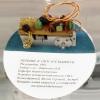Feed aggregator
Precision programmable current sink

The TL431 has been around for nearly 50 years. During those decades, while primarily marketed as a precision adjustable shunt regulator, this legacy device also found its way into alternative applications. These include voltage comparators, audio amplifiers, current sources, overvoltage protectors, etc. Sadly, in almost every example from this mighty menagerie of circuits, the 431’s “anode” pin sinks to the same lowly fate. It gets grounded.
Wow the engineering world with your unique design: Design Ideas Submission Guide
Current sink regulation
The design idea presented here offers that poor persecuted pin a more buoyant role to play, Figure 1.

Figure 1 The floated anode serves as a sense pin for active current sink regulation.
The Figure 1 block diagram shows how the 431 works at a conceptual level where:
Sink current = Is = (Vc – 2.5v)/R1 = 0 to 1/R1 as Vc = 2.5v to 3.5v
Vs < 37v, Is < 100mA, Is(Vs – R1Is) < 500mW @ 50oC ambient
Series connection adds an internal 2.5-V precision reference to external voltage input on the ANODE pin. The op-amp subtracts this sum from the voltage input on the REF pin, then amplifies and applies the difference to the pass transistor. If the difference is positive (sum < REF), the transistor turns on and shunts current from CATHODE to ANODE. Otherwise (sum > REF), it turns off.
If the 431 is connected in the traditional fashion (REF connected to CATHODE and ANODE grounded). In that case, the scheme works like a shunt voltage regulator should, forcing CATHODE to a resistor-string-programmed multiple of the internal 2.5-V reference voltage. But what will happen if the REF pin is connected to a constant control voltage (Vc > 2.5 V); and the ANODE, instead of being grounded, floats freely on current sensing resistor R1?
What happens is the current gets regulated instead of the voltage. Because Vc is fixed and can’t be pulled down to make REF = ANODE + 2.5, ANODE must be pulled up until equality is achieved. For this to happen:
Is = (Vc – 2.5v)/R1
Constant current sink regulation of 1/R1
Figure 2 illustrates how a fixed voltage divider might be used (assuming a 5-V rail that’s accurate enough) to use a floated-anode Z1 to regulate a constant sink current of:
Is = (3.5v – 2.5v)/R1 = 1/R1
It also illustrates adding a booster transistor Q1 to accommodate applications needing current or power beyond Z1’s modest TO92ish limits. Notice that Z1’s accuracy will be unimpaired because whatever fraction of Is that Q1 causes to bypass Z1 is summed back in before passing through R1.

Figure 2 Booster transistor Q1 can handle current and voltage beyond 431 max Ic and dissipation limits, while the 3.5-V voltage divider programs a constant Is.
Programming sink current with DAC
Figure 3 shows how Is might be digitally programmed with a 2.5-V DAC signal. Note the DAC signal is inverted (Is = max when Vx = 0) while Z2 provides the necessary level shift:
Is = (2.5v – Vx)/(2.5R1) = 0 to 1/R1 as Vx = 2.5v to 0

Figure 3 DAC control of Is, the DAC signal is inverted, while Z2 provides the necessary level shift.
Programming sink current to Df/R1 with DAC
Figure 4 shows an alternate programming method using PWM with Is = Df /R1 where Df equals the 0 to 1 (0% to 100%) PWM duty factor:
Is = (2.5R2/(R3/Df))/R1 as Df = 0 to 1
Df = IsR1R3/(2.5R2)
Df = Is R1

Figure 4 PWM control of Is, where Is is the ratio of the PWM duty factor and R1.
The 8-bit PWM resolution and 10-kHz frequency are assumed. The R2C1 single-pole ripple filter has a time constant of approximately 64x the PWM period (10 kHz = 100 µs assumed) for 1-lsb peak-to-peak max ripple and 38-ms max settling time.
Speeding up settling time
One shortcoming of Figure 4 is the long settling time (~40 ms to 8 bits) imposed by the single-pole R1C1\2 ripple filter. If an extra resistor and capacitor won’t break the bank, that can be sped up by a factor of about 5 (~8 ms) with Figure 5’s R5C2 providing 2nd-order analog-subtraction filtration.

Figure 5 The addition of R5 and C2 provides faster settling times with a 2nd-order ripple filter.
Programmable current sink application circuit
Finally, Figure 6 shows the Figure 4 circuit combined with an inexpensive 24-W AC adapter and a 5-V regulator to power a small digital testing system. Be sure to adequately heatsink Q1.

Figure 6 The combined current sink and small system power supply where the max Is is 1 A, Max Vs is 20 V, and Is = Df.
Thanks for the implicit suggestion, Ashutosh!
Stephen Woodward’s relationship with EDN’s DI column goes back quite a long way. Over 100 submissions have been accepted since his first contribution back in 1974.
Related Content
- Cancel PWM DAC ripple with analog subtraction
- TL431 Model
- PWM-programmed LM317 constant current source
- A negative current source with PWM input and LM337 output
- A high-performance current source
- VCO using the TL431 reference
The post Precision programmable current sink appeared first on EDN.
П'єзоелектричні двигуни – створено в КПІ
У Державному політехнічному музеї імені Бориса Патона відкрито виставку "П'єзоелектричні двигуни – створено в КПІ". Можливість організувати її з'явилася торік, коли співробітники музею під час дослідження одного окремого експонату музейної колекції – п'єзодвигуна отримали для поповнення музейного фонду окрім інформаційного матеріалу ще й унікальну колекцію зразків таких двигунів.
Tell us your Tale!

Dear EDN Readers,
We’re thrilled to announce the successful expansion of our Design Ideas section. Thanks to your support, we now publish two new DIs every week!
We’re also excited to revitalize our Tales from the Cube column. This platform allows engineers to share their unique experiences in solving challenging design issues—whether they encountered a product failure, dealt with troublesome equipment, or tackled a persistent problem on a personal project.
We aim to regularly update this column with fresh content. With your contributions, we hope to gradually breathe new life into Tales from the Cube with new articles to feature in our Fun Friday newsletter.
Here are some FAQs to get you started:
What are Tales from the Cube articles?
Tales from the Cube are generally brief, focused narratives where engineers outline how they arrive at a solution to a specific design challenge or an innovative approach to a design task. This can relate to a personal project, a contract, or a corporate design dilemma. Here are some basic guidelines that might help you as you write out your article:
- 600-1000 words
- 1-2 images
- One-sentence summary of your story that goes along with the title
- A short author bio
What technology areas are allowed?
We’re open to a wide range of technology areas, including (but not limited to) analog and digital circuits, RF and microwave, programmable logic, hardware-design languages, systems, programming tips, utilities, test equipment and techniques, power, and more. If you’re not sure about your topic, just email us at editors@aspencore.com.
Do I get paid for a Tales from the Cube article?
Yes! Monetary compensation for each Tales from the Cube article is $200 USD, not enough to keep the lights on, but it does offer you an avenue to tell your unique engineering story to tens of thousands of engineers globally and engage in some interesting conversations about your engineering remedy.
How can I submit a Tales from the Cube article?
Feel free to email us at editors@aspencore.com with your questions, thoughts, or a completed article. So, Tell us your Tale!
The post Tell us your Tale! appeared first on EDN.
ЕнІнХаб: від ідеї до втілення
Останнім часом під словом хаб розуміють такі поняття, як центр діяльності, центр подій, майданчик для впровадження проєктів, ідей тощо. Але функціонування Енерго-Інноваційного Хабу (далі – ЕнІнХаб) КПІ ім.
Звіт голови Профспілкового комітету студентів КПІ ім.Ігоря Сікорського Ігоря Степанюка про виконання Колективного договору за період з квітня 2024 до квітня 2025 р.
Третій рік повномасштабного вторгнення значно змінює роботу університету і Профкому студентів загалом. Але не можна постійно списувати відсутність зростання на війну, потрібно розвиватися і йти вперед.
На війні загинув випускник ФЕА Віктор Слуговина
Із сумом повідомляємо, що продовжує надходити інформація щодо КПІшників, які загинули на війні.
Слуговина Віктор Олегович (12.04.1994 – 09.10.2024)
EEVblog 1682 - Enphase Microinverter FAIL & Warranty Install
flappybird inside integrated circuit (IC)
 | guys i finished my flappy bird logic ic i made it on my fone btw [link] [comments] |
Revealing the infrasonic underworld cheaply, Part 1

Editor’s Note:
Part 1 of this DI uses an electret mic to create infrasound. It starts with a basic equalization circuit validated with a DIY test fixture and simulations, and ends with a deeper analysis of the circuit’s real response.
Part 2 includes refinements to make the circuit more usable while extending its detectable spectrum with an additional technique that allows us to hear the infrasonic signals.
Although electret microphones are ubiquitous, they are more versatile than might be expected. With some extra equalization, their frequency responses can be made to range from earthquakes to bats. While this Design Idea (DI) ignores those furry mammals, it does show how to get a reasonably flat response down to way below 1 Hz.
Wow the engineering world with your unique design: Design Ideas Submission Guide
Electrets aren’t only used as audio pickups. For decades, they have been employed in security systems to detect unexpected changes of air pressure within rooms, while more recently they can be found in vapes as suck-sensors (or, more technically, “draw sensors”, according to Brian Dipert’s recent teardown).
An excellent description of their construction and use, complete with tear-down pictures, can be found here. The capsules I had to hand were very similar to those shown, being 10 mm in diameter by 6 mm high. Some experiments to check their frequency response—practical details later—showed a steady 6 dB/octave roll-off below about 15 Hz, implying that a filter with an inverse characteristic could flatten the response down to a fraction of a Hertz. And so it proved!
Building an equalization circuit
A basic but usable circuit capable of doing this is given in Figure 1.

Figure 1 Simple equalization can extend the low-frequency response of an electret microphone down to well under 1 Hz.
While this exposes some problems, which we’ll address later, it works and serves to show what’s going on. R1 is chosen to give about half the rail voltage across the mic, and A1 boosts the signal by ~21 dB. At very low frequencies, A2’s stage has a maximum gain of ~30 dB. This falls by 6 dB/octave from ~160 mHz upwards, reaching unity gain at ~4.8 Hz. C3/4 and R7/8 top and tail the response, and A3 boosts the level appropriately. (Not shown is a rail-splitter, defining the central, common rail.) The op-amps used were MCP6022s because of their low input offset voltage.
The low 3-dB point is largely determined by C1/R2. (Adjusting the values of R5, R6, and C2 and adding an extra resistor in series with C2 would, in principle, let us equalize a specific mic to give a flat response from a few hundred millihertz up to its upper limit.)
Figure 2 shows the overall response to changes in air pressure, with 3 dB points at about 500 mHz and 12 Hz. While this is an LTspice-derived trace, it closely matches real-world measurements.

Figure 2 The response of Figure 1’s circuit to air-pressure changes at different frequencies.
Validating the frequency response
That confidence about the actual response may raise some eyebrows, given the difficulty in getting decent bass performance in even the best of hi-fi systems. A custom test rig was called for, using a small speaker to produce pressure changes in a sealed chamber containing a mic-under-test. It’s shown in Figure 3.

Figure 3 Two views of a test rig allowing sub-Hz measurements of a microphone’s frequency response.
The rig comprises an IP68 die-cast box fitted with a 50 mm plastic-coned speaker (42 ohms) and a jam-jar lid, the jar itself being the test chamber for the mic, which, when fitted with pins, could be swapped. Everything was sealed with lots of epoxy, plus some varnish in case of pinholes. A generous smear of silicone grease guaranteed that the jar seated almost hermetically. The speaker was driven by a custom sine-wave oscillator based on a simple squashed-triwave design and covering from 90 mHz to 11 Hz in two ranges.
This is actually the Mark 3 version. Mark 1 was based on a cut-down, wide-mouthed tablet bottle with a speaker fixed to it, which was adequate for initial tests but let in too much ambient noise for serious work. Mark 2 added a jam jar as a baffle behind the speaker, but the bottle’s walls were still too flexible. The more rigidly-constructed Mark 3 worked well, with an unequalized frequency response that was flat within a decibel from about 20 to 200 Hz. (It had a major cavity resonance at about 550 Hz, too high to affect our results.)
Simulations, mostly in hardware
To verify the performance of the rig itself at the lowest frequencies, some simulation was needed—but in hardware, not just with SPICE. Stripping a spare mic down to its bare JFET (a Sanyo 2SK156) and adding some components to that meant that it could be driven electrically rather than acoustically while still looking like the real thing to the circuit—or almost. The main divergence did not affect the frequency response, but did throw light on some unexpected behavior. The simple schematic is in Figure 4; the concept also worked well in LTspice, using their default “NJF” JFET, and formed part of Figure 2’s simulation.

Figure 4 A circuit that simulates an electret microphone in real life.
Once the circuit had settled down, the measured frequency responses using the test rig and the simulated mic matched closely, as did the LTspice sim. With the simulated mic, settling took a few seconds, as expected given the circuit’s long time constants, but with a real mic, it took many times as long. Perhaps the diaphragm was relaxing, or something? Another mic, torn down until only the JFET remained, behaved similarly (and, with its floating gate lead, made a near-electrometer-quality mains-hum probe!).
Curious behavior in a JFET, and how to fix it
It seemed that the FET’s gate was misbehaving—why? Perhaps charge was being injected when power is applied, and then leaking slowly away? Ramping the voltage up gently made some difference, but not enough to explain things fully. It appears that leakage is dominant, and that charge on the gate slowly equalizes, producing a long, slow “tail” which is still just fast enough to produce an offset at the circuit’s output, even with two C-R networks attempting to block it. With the low impedance on the simulated mic’s gate, such effects are negligible. It’s stuff that would never show up in audio work.
From this, we can deduce that the mic’s low 3-dB point is determined not by the FET’s time-constant but by the “acoustics” within the mic. But that extra, inherent time constant still needs addressing if the circuit is to settle in a reasonable time. If the gate must slowly drift towards equilibrium owing to leakage, could we inject a packet of charge at start-up to compensate? Experiments using the circuit of Figure 5 were successful, albeit empirically; the values given are cut-and-try ones. Shorting R1 for about 3 ms gave a pulse of double the final voltage across the mic, and that proved to be optimum for the available capsules in the circuit as built. The settling time is still around 10–15 seconds, but that’s a lot better than over a minute.

Figure 5 A few milliseconds of over-voltage applied across the mic at start-up injects enough charge to counterbalance much of the FET’s longer-term start-up drift.
This is also useful in the case of an overload, which sends the output off-scale. If that happens, you can now use the time-honored method of switching off, waiting a few seconds, and switching back on again!
Real-life response
Figure 6 shows the actual response as measured using the test rig. It’s a composite of two scans, one for each range. (Because tuning was done manually, the frequency scale is only roughly logarithmic.) R9 was set to about 50k, so the output stage had a gain of around 6.

Figure 6. The response of the circuit in Figure 1, measured using Figure 3’s test rig.
The upper trace is the driving waveform for the speaker, showing that a positive-going output from the circuit corresponds to increased pressure within the rig’s chamber. (From this, we can infer that the negatively-poled side of the electret film itself faces the JFET’s gate. That makes sense, because a serious acoustic insult like a handclap right in front of the mic will then charge the gate negatively, and excess negative charge drains away more easily through the JFET’s gate-source diode than positive charge can, speeding recovery from any such overload.)
Note how the baseline wanders. That is mostly due to 1/f or flicker noise in the mic capsule’s JFET; both the bare JFET and the simulated mic show a similar effect, while a resistor is much quieter. We can extend the LF response further, but only at the expense of a worse S/N ratio. And below a Hertz or two, the effects of wind and weather seem to be dominant, anyway.
Viewing the results
There are several further desirable refinements and additions, but they must wait for Part 2. We’ll close this part with some ways of seeing what’s lurking below our ears’ cutoff point. (And Part 2 will also show how to listen to it.)
An oscilloscope (usually bulky, static, and power-hungry) is too obvious to mention, so we won’t. A cheap 50–0–50 µA meter connected between the output and common via a suitable resistor worked, but its response was 50% down at ~2 Hz.
A pair of LEDs, perhaps red and green for positive- and negative-going swings, looked good, though the limited swings available with the 5 V rail meant that the drive circuit needed to be somewhat elaborate, as shown in Figure 7. Caution! Its power must come directly from the power input to avoid the LEDs’ currents disturbing the mic’s supply, which would (and did) cause distortion and even (very) low-frequency oscillation. A good, stable power source is needed anyway.

Figure 7 One LED lights up on positive swings and the other on negative ones, the intensities being proportional to the signal levels.
Part 2 will extend the detectable spectrum a little while mostly concentrating on making the basic circuit more usable. An audible output will mean that we will no longer have to worry about the Zen-like problem of, “if we can’t hear it, should we call it a sound?”
—Nick Cornford built his first crystal set at 10, and since then has designed professional audio equipment, many datacomm products, and technical security kit. He has at last retired. Mostly. Sort of.
Related Content
- Squashed triangles: sines, but with teeth?
- A pitch-linear VCO, part 1: Getting it going
- Earplugs ready? Let’s make some noise!
- Supersized log-scale audio meter
The post Revealing the infrasonic underworld cheaply, Part 1 appeared first on EDN.
Vishay Intertechnology Thick Film Power Resistor With Optional NTC Thermistor and PC-TIM Simplifies Designs and Saves Board Space
AEC-Q200 Qualified Device in Compact SOT-227B Package Offers High Pulse Handling Capability and Power Dissipation to 200 W
Vishay Intertechnology, Inc. introduced a new AEC-Q200 qualified thick film power resistor in the compact, low profile SOT-227B package for mounting on a heatsink. Available with an optional NTC thermistor for internal temperature monitoring and pre-applied Phase Change Thermal Interface Material for more efficient mounting, the Vishay MCB ISOA200 offers high pulse handling capability and high power dissipation up to 200 W at an 80 °C bottom case temperature.
Built on an exposed alumina substrate instead of a metal tab, the device released, lowers costs and weight for automotive, industrial, and avionics, military, and space (AMS) applications, in which it will serve as a precharge, discharge, active discharge, or snubber resistor. For applications subject to high and repetitive pulse surges, the resistor can handle high energy pulses up to 140 J for 0.1 s and is multi-pulsed tested. Additional custom testing options for the device are also available.
With the option to integrate an AEC-Q200 qualified, temperature cycle tested NTC thermistor inside the resistor package, the ISOA200 simplifies designs and saves board space, while its optional PC-TIM streamlines installation in production. The device’s high power and high energy dissipation further simplify designs while lowering costs by reducing the need for power components.
The ISOA200 features a resistance range from 10 Ω to 1 MΩ, with tolerances of ± 5 % and ± 10 %, and TCR of ± 100 ppm/K and ± 150 ppm/K. The resistor offers a maximum operating voltage of 1500 V, an operating temperature range of -55 °C to +150 °C, and dielectric strength of 4000 Vrms. The RoHS-compliant device offers a non-inductive design and can include two different resistors.
The post Vishay Intertechnology Thick Film Power Resistor With Optional NTC Thermistor and PC-TIM Simplifies Designs and Saves Board Space appeared first on ELE Times.
Microchip Introduces PIC16F17576 MCU Family to Simplify Analog Sensor Design
Integrated low-power analog peripherals reduce design costs and complexity
Devices designed for capturing rapidly changing analog signals must respond quickly while consuming minimal power, especially in battery-operated applications. To address these demands, Microchip Technology has released the PIC16F17576 microcontroller (MCU) product family with integrated low-power peripherals and the ability to precisely measure volatile analog signals.
PIC16F17576 MCUs feature a new low-power comparator and voltage reference combination that can operate while the MCU core is in sleep mode, allowing for continuous analog measurement while consuming less than 3.0 µA of current. The Analog Peripheral Manager controls which peripherals are active to minimize total energy consumption and enable battery-operated applications to monitor signals effectively without excessive power drain.
Engineered for applications that measure volatile analog signals, PIC16F17576 MCUs include operational amplifiers with software-controlled gain ladders. This feature enables a single op amp to switch between multiple gain options, helping mitigate noise while maintaining precision and power efficiency. Equipped with up to four op amps and a 12-bit differential ADC with automated averaging, the MCUs enable precise signal measurement over a wide range of inputs.
“Sensor systems can quickly become complex, often requiring multiple analog components that add board size, cost and power draw,” said Greg Robinson, corporate vice president of Microchip’s MCU business unit. “With the integrated analog features in our low-power PIC16F17576 MCUs, we’re cutting that complexity. You can eliminate parts and reduce power consumption, cutting costs and simplifying the overall design process.”
PIC16F17576 MCUs are well suited for measuring analog signals in a number of industries, including environmental and industrial monitoring, smart home and building automation. Key applications include vibration and strain measurement, flow metering, gas detection, cold asset tracking and motion sensing.
The post Microchip Introduces PIC16F17576 MCU Family to Simplify Analog Sensor Design appeared first on ELE Times.
Rohde & Schwarz receives VESA approval for DisplayPort testing solutions
Rohde & Schwarz test solutions have been officially approved by the Video Electronics Standards Association (VESA) for testing DisplayPort technology. This achievement reinforces the company’s commitment to delivering high-quality solutions for testing of the physical layer compliant with various industry standards.
VESA has officially approved the test solutions from Rohde & Schwarz for DisplayPort 2.1 (HBR X) transmitter testing, providing manufacturers a toolset to validate their DP2.1 (HBR X) transmitters with confidence. This test solution is based on the R&S RTP oscilloscope and R&S ScopeSuite test automation software.
Additionally, Rohde & Schwarz vector network analyzers have been approved for DisplayPort cable/connector testing, supporting various data rates including DP80 (UHBR20), DP54 (UHBR13.5 and UHBR10), and DP8k (HBR3). The brand-new R&S ZNB3000 with its exceptional measurement speed is an ideal fit for this application and reduces the test time significantly. The R&S ZNBT multiport VNA and other vector network analyzers from Rohde & Schwarz are capable of performing this task, as well.
Beyond VESA-approved testing, the Rohde & Schwarz solutions also seamlessly integrate Embedded DisplayPort (eDP) transmitter testing, providing design engineers with a unified platform for comprehensive DisplayPort technology evaluation. This integrated approach enables manufacturers to efficiently test and optimize eDP transmitters utilizing the R&S RTP and R&S ScopeSuite solution.
Patrick McKenzie, Technology Manager, at Rohde & Schwarz, said: “We’re pleased to receive VESA’s approval for our DisplayPort testing solutions. This confirms our commitment to precise and reliable test tools for the evolving display technology landscape. Our solutions empower our customers develop innovative DisplayPort products quickly and efficiently, while meeting industry standards.”
The post Rohde & Schwarz receives VESA approval for DisplayPort testing solutions appeared first on ELE Times.
Microchip Unveils New High-Density Power Module for AI at the Edge Applications
The MCPF1412 power module with integrated I2C and PMBus interfaces for flexible configuration and monitoring
AI at the edge is driving increased integration and power consumption, requiring advanced power management solutions for industrial automation and data center applications. Microchip Technology announced the MCPF1412, a highly efficient and fully integrated point-of-load 12A power module with a 16V VIN buck converter and support for I2C and PMBus interfaces.
The MCPF1412 power module is designed to deliver superior performance and reliability, ensuring efficient power conversion and reduced energy loss. Its compact form factor of 5.8 mm × 4.9 mm × 1.6 mm and innovative Land Grid Array package significantly reduce the required board space by over 40% compared to traditional discrete solutions. This reduction in size, coupled with enhanced reliability and minimized PCB switching and RF noise, positions the MCPF1412 as a leading industry device.
“The MCPF1412 is highly compatible with our FPGAs and PCIe solutions, providing a comprehensive solution for Microchip customers,” said Rudy Jaramillo, vice president of Microchip’s analog power interface division. “This innovative solution minimizes space usage by reducing chip placements when combined with other Microchip devices.”
The MCPF1412M06 is a versatile device that offers significant flexibility for configuration and system monitoring through the I2C and PMBus interfaces. Additionally, it supports standalone operation without a digital interface, allowing designers to easily configure output voltages using simple resistor divider adjustments and monitor the system via the Power Good output.
Other key features of the MCPF1412 include multiple diagnostic functions such as over-temperature, over-current and over-voltage protection for improved performance and reliability. The operating temperature range is TJ −40°C to +125°C. An on-board embedded EEPROM is available for programming the default power-up configuration.
Microchip offers a wide range of DC-DC power modules with input voltages from 5.5-70V, available in ultra-compact, rugged and thermally enhanced packaging to improve high power density.
The post Microchip Unveils New High-Density Power Module for AI at the Edge Applications appeared first on ELE Times.
Semikron Danfoss’ module with ROHM’s latest 2kV SiC MOSFETs integrated into SMA’s large-scale solar system
XENSIV 4th generation of magnetic switches supports functional safety up to ASIL B in automotive applications
When developing applications for autonomous driving, compliance with the ISO 26262 standard is crucial – at both the system and sensor levels. To meet these demands, Infineon Technologies AG introduces the XENSIV TLE4960x magnetic switch family. Developed in accordance with ISO 26262, the TLE4960x switches integrate diagnostic functions to support functional safety applications with requirements up to ASIL B. They are the only ASIL-B-compliant switches on the market that can address a wide range of automotive applications, including window regulators, sunroof actuators, and seat adjustment. In addition, the devices are AEC-Q100 compliant and qualified to Grade 0, ensuring robust performance in harsh environments.
The TLE4960x devices are designed to measure the magnetic field orthogonal to the printed circuit board in the Z-direction and feature an open-drain output for speed information. They also include integrated overcurrent and overtemperature protection. Housed in a standardized SOT23-3 SMD package, the sensors require only 1.6 mA and operate across an extended temperature range from -40°C to 175°C. Their excellent temperature stability makes them ideal for harsh automotive environments.
The post XENSIV 4th generation of magnetic switches supports functional safety up to ASIL B in automotive applications appeared first on ELE Times.
The advent of recyclable materials for PCBs

Conventional PCB manufacturing—which is wasteful, energy intensive, and harmful to the environment—increasingly calls for electronics recycling to reduce material waste and energy requirements through less material production.

Figure 1 The conventional PCB world is ripe with recycling opportunities. Source: IDTechEx
IDTechEx’s new report, “Sustainable Electronics and Semiconductor Manufacturing 2025-2035: Players, Markets, Forecasts,” outlines new recyclable materials for PCBs and provides updates on their full-scale commercial readiness. Below is a sneak peek at these recyclable and biodegradable materials and how they facilitate sustainability in electronics manufacturing.
- New PCB substrates
While FR4, a glass-reinforced epoxy resin laminate, is a substrate of choice for PCBs due to being lightweight, strong, and cheap, it’s non-recyclable and can contain toxic halogenated flame retardants. That calls for alternative substrates that are biodegradable or recyclable.
Jiva’s Soluboard, a biodegradable substrate made from the natural fiber flax and jute, is emerging as a promising new material as it dissolves in 90°C water. That facilitates component recycling and precious metal recovery at the product’s end of life. Companies like Infineon, Jaguar, and Microsoft are currently testing if this new material can combat rising electronics waste levels.

Figure 2 Soluboard is a fully recyclable and biodegradable PCB substrate. Source: Jiva Materials
- Polylactic acid in flexible PCBs
Conventional flexible PCBs, built around plastic polyimide, are also ripe for alternative materials. Polylactic acid, currently in the prototype-scale validation phase, emerges as a sustainable material that can be sourced from organic industrial waste and is also biodegradable.
Polylactic acid can withstand temperatures of up to 140°C, which is lower than that of polyimide and FR4. However, it’s compatible with manufacturing processes such as silver ink sintering. Companies and research institutes like VTT are now demonstrating the potential of polylactic acid in flexible PCBs.
- Recycled tin
Around 180,000 tonnes of primary tin are used in electronics globally. It’s primarily sourced from mines in China, Indonesia and Myanmar and is causing significant environmental damage. Enter recycled tin, which is produced by smelting waste metal and metal oxide. It boasts the same quality as primary tin, which is confirmed by X-ray diffraction.
However, merely 30% of tin is currently recycled worldwide, so there is a greater need for regulatory drivers to encourage increased metal recycling. One example is Germany’s National Circular Economy Strategy (NKWS) unveiled in 2024, aiming to half per capita raw material consumption by 2045.

Figure 3 A boost in recycled tin relies on a strong regulatory push. Source: Mayerhofer Electronik
Mayerhofer Electronik was the first to demonstrate the use of recycled tin for soldering in its electronics manufacturing processes. Now, Apple has committed to using secondary tin in all products by 2035.
- Regeneration systems to minimize copper waste
It’s a widely known fact that copper is used wastefully in PCBs. This is how it happens: a flat sheet of copper is applied to the substrate before holes are drilled. Inevitably, a circuit pattern produced by etching away the excess copper requires large volumes of chemical etchants like ferric (III) chloride and cupric (II) chloride. As a result, around 70% of the copper initially applied to the board is often removed.
Here, additive manufacturing, in which copper is only applied where required, offers the solution in a method that requires no manufacturing switch. An etchant regeneration system recovers both copper etched from the laminate and etchant chemicals. The recycled copper can serve as an additional revenue stream for the electronics manufacturer.
Related Content
- The problem with recycling
- PCB materials: Recycle, reuse, dispose?
- Trends and Challenges in PCB Manufacturing
- Process for recycling turns up components ready for reuse
The post The advent of recyclable materials for PCBs appeared first on EDN.
Гідні умови праці та кар'єрне зростання пропонує НАЕК "Енергоатом"
Топменеджери атомної енергетичної галузі в середині березня завітали до НН ІАТЕ, відвідали лабораторії та науково-дослідний центр, ознайомилися з інноваційними підходами до навчання, зустрілися зі студентами, науковими й науково-педагогічними працівниками Інституту та обговорили важливість підготовки висококваліфікованих спеціалістів для енергетичної галузі. Фахівці з персоналу АТ НАЕК "Енергоатом" відзначили високий рівень знань і затребуваність випускників КПІ ім. Ігоря Сікорського.
Утвердження гендерної рівності: крок за кроком
Газета "Київський політехнік" вже розповідала про основні засади, покладені в основу Плану дій з імплементації принципів гендерної рівності в практику діяльності КПІ, затвердженого наказом ректора від 3 жовтня 2024 року. Наприкінці березня відбулося розширене засідання робочої групи з питань гендерної рівності КПІ ім. Ігоря Сікорського, участь у якому окрім її членів взяли представники низки підрозділів і ректор університету Анатолій Мельниченко.
Звіт голови Профспілкового комітету КПІ ім.Ігоря Сікорського Юрія Веремійчука про виконання Колективного договору за період з квітня 2024 до квітня 2025 р.
Шановні делегати Конференції трудового колективу, працівники та здобувачі вищої освіти університету, запрошені!










